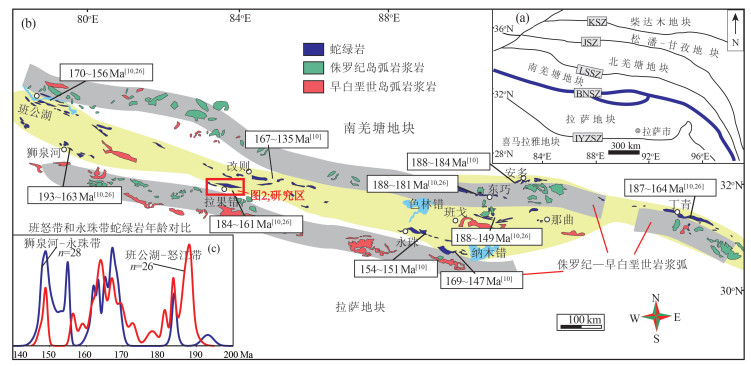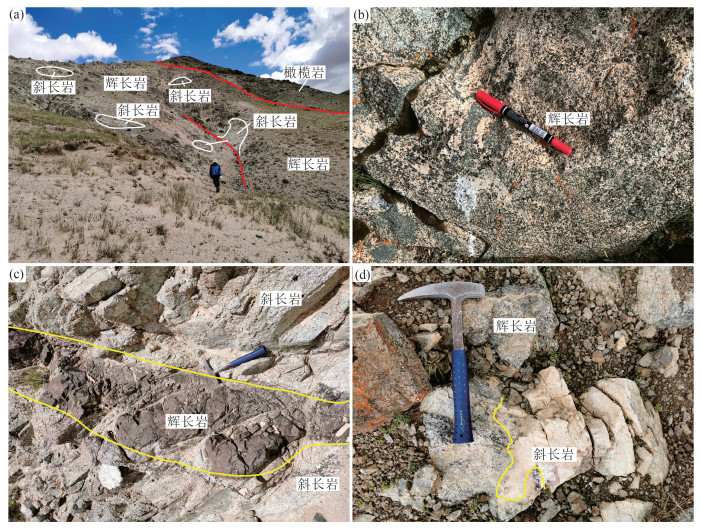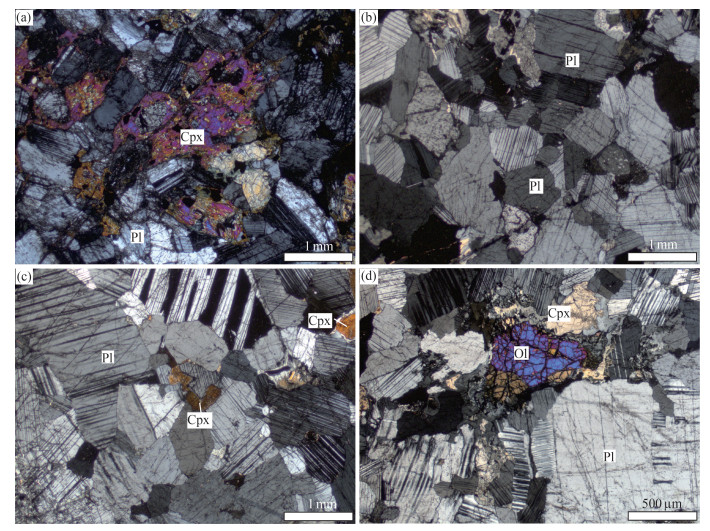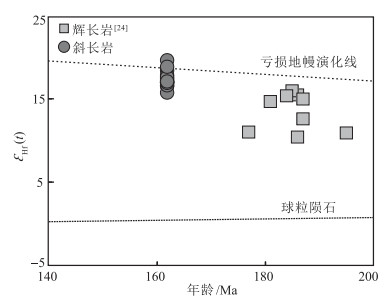Petrogenesis of anorthosite in the Laguoco ophiolite western part of the Bangong-Nujiang suture zone and its constraint to the evolution of the Meso-Tethys Ocean
-
摘要:
拉果错蛇绿岩位于青藏高原北部的改则地区,是狮泉河-永珠带内保存最好、岩石组合最完整的蛇绿岩之一。为进一步约束拉果错蛇绿岩成因及其构造属性,对其中斜长岩开展了详细的岩石学、锆石U-Pb年代学和地球化学研究。结果显示,斜长岩主要呈不规则脉体或透镜体侵入到辉长岩中,锆石U-Pb定年结果表明斜长岩形成于162 Ma,略晚于蛇绿岩中基性岩形成时代。这些锆石均具有明显正的εHf(t)值(+15.8~+19.7),暗示其岩浆源自亏损的地幔源区。斜长岩具有明显低SiO2、TiO2和高CaO的特征,具有与正常型大洋中脊玄武岩(N-MORB)类似的稀土元素配分形式和低的微量元素含量,富集Rb、Ba、Th和Sr,亏损Nb、Ta、Zr等微量元素。此外,斜长岩显示出高的Nb/La值和低的Th/Nb、Ba/Nb值,暗示其源自富集地幔源区高程度的部分熔融,形成过程还受到俯冲组分的影响。综合上述特征,推测拉果错斜长岩是地幔柱影响下再富集的亏损地幔源区高程度部分熔融的产物。俯冲过程中,再富集地幔源区(地幔楔)产生的原始岩浆快速上涌过程,并伴随着富Mg-Fe矿物的结晶分异,残余富Ca、Al岩浆。残余岩浆侵入到俯冲带上盘洋壳中(辉长岩),由于快速减压而形成斜长岩。结合区域研究成果,表明拉果错蛇绿岩形成于与早侏罗世—晚侏罗世早期俯冲相关的构造背景。
Abstract:The Laguoco ophiolite is distributed in the Gaize area, north Tibetan plateau, and is one of the most complete and well-preserved ophiolites in the Shiquanhe-Yongzhu belt. The petrological, zircon U-Pb geochronology and geochemistry of anorthosite intruding gabbros are studied to manifest the genesis and tectonic affinities of the Laguoco ophiolite. The anorthosite was emplaced within gabbros mainly as irregular dikes or lenses, with zircon U-Pb ages of 162±1 Ma, slightly later than mafic rocks of the ophiolite. All zircons yield remarkable positive εHf(t) values (+15.8~+19.7), indicating that the magma was derived from a long-term depleted mantle source. All anorthosites are characterized by low SiO2, TiO2 and high CaO contents, MORB-like REE patterns with low trace element concentrations, enrichment of Rb, Ba, Th and Sr, and depletion of Nb, Ta and Zr. Moreover, these samples show high Nb/La but low Th/Nb and Ba/Nb ratios, which suggests their magma was affected by enriched mantle with variable inputting of subduction materials. The comprehensive analysis suggests that the Laguoco anorthosite was derived from high degree partial melting of depleted mantle source with re-enrichment of plume. The primary magma deriving from (enriched) mantle wedge rapidly ascended into oceanic crust in company with the crystallization differentiation of Mg-Fe oxides. Then, residual Ca, Al-bearing magma injected into the gabbros and formed anorthosite with the decrease of pressure. Combining with regional geology, it is suggested that the Laguoco ophiolite was formed in a subduction-related setting during the Jurassic.
-
Keywords:
- Bangong-Nujiang suture zone /
- Shiquanhe-Yongzhu belt /
- ophiolite /
- anorthosite /
- zircon U-Pb age
-
江西省是中国重要的有色及贵金属产地,也是环太平洋成矿带的组成部分之一。长期以来,钦杭成矿带在铜、铅、锌、钨、锡、金、银、铁等矿种找矿勘查和科研方面均取得了重要进展。近年来在赣南—武夷地区,相继发现了园岭寨、铜坑嶂、葛廷坑、新安、熊家山、金竹坪等钼矿床,另外,在赣北地区又发现了大湖塘、石门寺、朱溪等钨矿床,使地质工作的中心向北部地区转移,提出“南钨北扩”的思想,使钨钼矿找矿勘查及成矿理论研究得到较大的进步。赣中地区的“新余式铁矿”,是中国重要的BIF型铁矿产地之一,在铁矿的勘查研究方面取得了较多的成果;对其他类型的金属矿床研究较少,且多以钨矿床及钨钼多金属矿床为主,如徐山钨矿、大王山钨矿、阳储岭钨钼矿床、浒坑钨钼矿床等。近年来,随着矿山开采深度的增加,在良山铁矿区发现了具有工业价值的钼矿体。现阶段工作证实,良山钼矿床具有良好的工业价值,钼资源储量达到中等规模,赣中地区具有钼矿床的找矿前景。
锆石是广泛存在于地质体中的一种副矿物。具有高U、Th值,却很少含Pb, 抗侵蚀能力很强,形成后不受外界因素的干扰。锆石是岩浆结晶年龄测定最理想的矿物,尤其适合酸性侵入岩测年[1]。本文选取矿区内与成矿关系密切的良山斑岩体进行LA-ICP-MS锆石U-Pb年龄测定,获取准确的成岩年龄;同时,为确定该矿床的成矿时代,选取矿床的主要矿石矿物辉钼矿进行Re-Os同位素测定。以期查明成岩时代与成矿时代的世代关系,探讨成岩、成矿之间的关系,为深入研究该矿床的成因、深化区域成矿规律研究及指导同类矿床的进一步找矿提供科学依据。
1. 矿床地质特征
赣中良山钼矿主要分布于赣中地区中西部,钼矿床与新余良山铁矿产出位置相同,成矿区带为钦杭成矿区带(江西段);大地构造位置为钦杭结合带南侧边缘,南华造山带北缘武功山-北武夷隆起带西段。次一级区域构造为武功隆起带东段[2]的神山倒转背斜南翼北东、黄虎背形[3]向斜轴线以东的单斜构造[4-6](图 1),是铁矿田的区域性控矿构造,由东西向神山倒转背斜的南翼及其西部外倾转折端组成。神山复背斜由青白口系神山组构成核部,而南翼则由南华系上施组、下坊组和大砂江地层组成。
![]() 图 1 江西新余铁矿田区域地质简图(据参考文献[6]修改)Q—第四系;Z1l—乐昌群老虎塘组;Z1b—乐昌群坝里组;Nh2xf2—杨家桥群下坊组上段;Nh2xf1—杨家桥群下坊组下段;Nh2g—杨家桥群古家组;γ5—燕山期石英闪长岩;γ4—印支二云母花岗岩;γ3—加里东期花岗闪长岩;F—断层及推测断层图;★—良山钼矿所在地Figure 1. Geological map of the Xinyu iron orefield, Jiangxi Province
图 1 江西新余铁矿田区域地质简图(据参考文献[6]修改)Q—第四系;Z1l—乐昌群老虎塘组;Z1b—乐昌群坝里组;Nh2xf2—杨家桥群下坊组上段;Nh2xf1—杨家桥群下坊组下段;Nh2g—杨家桥群古家组;γ5—燕山期石英闪长岩;γ4—印支二云母花岗岩;γ3—加里东期花岗闪长岩;F—断层及推测断层图;★—良山钼矿所在地Figure 1. Geological map of the Xinyu iron orefield, Jiangxi Province区内构造活动非常强烈,褶皱构造与断裂构造均较发育。褶皱构造位于黄虎背形的倾伏端,轴线呈北西向展布,由倾向不同的倒转地层构成两翼,其次为同斜紧密褶皱构造。褶皱自地表向北西或北西西方向深部倾伏逐渐消失,具有浅繁深简的构造特点,并且在褶皱构造的基础上发育更次一级的断裂构造。断裂构造较发育,且有多期次活动的特点,主要有北东向、北西向、北北东向3组断裂构造。其中最主要的断裂构造是北东向,倾向南东,少数倾向北西,大多与褶皱轴平行或斜交,断层面倾角较陡,多属逆断层、复活断层,断层规模不大。
区内岩浆活动频繁,以侵入岩类为主。燕山期岩浆活动规模最大、最频繁、最强烈,岩石种类非常多。主要的岩浆岩有西部的山庄花岗闪长斑岩和东部的城上花岗岩体,两岩体皆呈岩基侵入于震旦系上部地层中,出露面积达120km2和164km2。张菲菲等[7]对山庄岩体测年,得到山庄花岗闪长岩年龄为424±3Ma(锆石U-Pb年龄)、楼法生等[8]测得的锆石U-Pb年龄为460.5±1.5Ma, 表明山庄岩体为加里东期复式岩体。城上岩体,李吉人[9]称其为金滩岩体,北部为加里东期斜长花岗岩,南部为华力西期(226±2Ma, 锆石U-Pb年龄)黑云母二长花岗岩,是一个多期次侵入的花岗岩体;其次为燕山期侵入酸性小岩体,在良山、北坑、粟木、城门北、武元、下桐岭、芳洲等地均有出露。
良山矿区出露的地层有南华系上施组、古家组、下坊组、松山组及第四系[10-11]。地层在矿区内总体倾向为北—北西向,倾角较平缓,多为20°~30°。南华系为一套浅变质相变火山岩-沉积岩组合。主要岩性有浅灰色、棕黄色变余砂岩、砂质千枚岩、石英砂岩、含砾绢云千枚岩、磁铁石英岩、变中酸性沉凝灰岩和含绿泥白云母石英片岩夹石英片岩薄层,以及褐灰色含炭质绢云石英片岩夹含锰白云质灰岩。石英粒晶普遍沿片理方向拉长,黑云母常退变质为绿泥石,本层自上而下黑云母减少,绿泥石增多。地层自井头矿区以东为向北倒转的层序,倾向北(北西)—北东,倾角20°~45°;以西为正常层序,倾向南西—西,倾角20°~70°。区内断裂构造发育,以北东—北北东向和北北西-北西向2组最发育。断裂构造是石英脉型钼矿体的赋矿部位,矿体及围岩蚀变主要沿断裂构造发育。区内岩浆岩主要为侵入岩,有东部的城上花岗岩体、西部的山庄花岗闪长岩和中部的良山石英闪长斑岩体。城上岩体(或称为金滩岩体)为多期复合岩体,呈岩基侵入震旦系上部地层中;北部为加里东期斜长花岗岩,南部为华力西期黑云母二长花岗岩,并有燕山早期花岗岩侵入[6](图 1)。良山岩体为燕山期小岩株,侵入含矿地层中,并且切割铁矿层,岩性主要为石英闪长斑岩、花岗闪长斑岩,近地表风化较严重,钼矿体主要产于岩体边缘外接触带(图 2)。区内变质岩系的变质程度不高,褶皱基底层为绿片岩相,局部的准盖层为亚绿片岩相,沉积盖层均未出现变质现象。由于经历了多期次的造山活动,变形及动力变质作用十分强烈。变质作用类型主要为区域变质作用,变质等级一般为绿片岩相,板岩、千枚岩发育,局部地段有云母片岩形成。在褶皱构造及其次级叠加构造之上发育的断裂构造为钼矿床的主要赋矿部位和控矿构造。
![]() 图 2 江西新余良山钼矿床地质简图(据参考文献[11]修改)Nh2xf2—杨家桥群下坊组上段;Nh2xf1—杨家桥群下坊组下段;Nh2s—潭头群上施组;γδπ52—燕山期石英闪长斑岩;γ4—印支期黑云母花岗岩;Fe—铁矿层;Mo—钼矿体;1—勘探线及编号;7802—钻孔及编号;F—正断层Figure 2. Geological map of the Liangshan molybdenum deposit in Xinyu County, Jiangxi Province
图 2 江西新余良山钼矿床地质简图(据参考文献[11]修改)Nh2xf2—杨家桥群下坊组上段;Nh2xf1—杨家桥群下坊组下段;Nh2s—潭头群上施组;γδπ52—燕山期石英闪长斑岩;γ4—印支期黑云母花岗岩;Fe—铁矿层;Mo—钼矿体;1—勘探线及编号;7802—钻孔及编号;F—正断层Figure 2. Geological map of the Liangshan molybdenum deposit in Xinyu County, Jiangxi Province良山钼矿床受勘查程度的影响,现阶段的主要矿体为良山斑岩体外接触带中产出的石英脉型钼矿,石英脉呈白色、乳白色块状,石英结晶较好、晶洞发育。矿石矿物为辉钼矿,金属矿物有黑钨矿、黄铁矿、黄铜矿、磁铁矿、闪锌矿等,脉石矿物主要为石英、绿泥石,次为方解石、绢云母、角闪石等。另外还含有极少量的副矿物,如磷灰石等。矿体的辉钼矿多呈灰黑色,颗粒较小,呈细小片状,一般为0.005~1.1mm, 少数粒度可达2mm。自形程度较差,有板片状、他形鳞片状、片状。但个别呈厚板状、带状分布,晶体常发生弯曲或挠曲,局部辉钼矿聚集呈玫瑰花状、束状或团块集合体,常发生弯曲,多色性也较明显。辉钼矿在石英脉中多以集合体形式产出,有脉状、团块状及薄膜状。
2. 锆石U-Pb测年
2.1 样品挑选及测试方法
用于锆石U-Pb定年的样品D011-01采于良山小岩体顶部,地理坐标为北纬27°38′55″、东经114°55′30″。锆石挑选在廊坊市地科勘探技术服务有限公司进行。野外采集2kg岩石样品,按照岩石中锆石的粒度,将样品按相应目数粉碎,反复淘洗,挑选出富集在重矿物组分中的锆石,随后进行电磁选分离,将样品按照不同磁性组分分选。在双目镜下对锆石样品进行挑选检查,除去其他残留矿物。按宋彪等[12]的锆石样品靶制作方法,将挑选好的无色透明、无裂隙、不含包裹体的锆石置于环氧树脂中,然后磨至约1/2,使锆石内部暴露,为防止击穿,磨掉的锆石部分均小于整体的1/2。待环氧树脂充分固化后,对样品进行抛光至最大面积露出锆石核部。之后在透射光与反射光下对锆石进行显微照相,并在阴极发光下对锆石进行图像观察与拍照,用以圈定测年用锆石颗粒的位置。锆石制靶及阴极发光(CL)照相由北京锆年领航科技有限公司完成。
锆石U-Pb同位素组成及微量元素组成分析在中国地质大学(武汉)地质过程与矿产资源国家重点实验室激光剥蚀等离子体质谱(LA-ICP-MS)仪器上完成,激光剥蚀孔径32μm, 脉冲8Hz, 以氦气作载气、氩气为补偿气以调节灵敏度。锆石年龄采用标准锆石91500作为外部标准物质,元素含量采用NIST610作为外标。样品分析流程为每测定5个样品点,测定2次锆石标准91500,在开始测量和测定结束后分别测定NIST610、91500和GJ-1等标样。每个样品点的数据采集时间共100s, 其中前20s为气体背景采集时间。由LA-ICP-MS获得的铅同位素数据采用Anderson的3D坐标法校正普通铅,离线数据采用软件ICP-MS DataCal完成后期处理。
2.2 测试结果
在进行锆石U-Pb测年分析前,在显微镜下对每个锆石的晶体形态进行观察并进行粒度统计,然后选择晶形好、包裹体和裂隙少的锆石颗粒制靶并进行阴极发光(CL)照相。测年锆石主要为半自形-自形晶,晶形完整,大多呈浅黄色-无色状,少量呈浅棕色,部分含有继承核,个别可见扇形分带结构。锆石颗粒粒径一般介于100~200μm之间,长宽比介于2:1~3:1之间;振荡环带生长边清晰,可见残留晶核(图 3)。锆石中振荡环带的形成受锆石结晶时岩浆温度的影响[13]。温度影响微量元素扩散的快慢,高温下微量元素扩散快,易形成较宽的结晶环带;低温下微量元素扩散慢,一般形成较窄的岩浆环带[14-15]。良山斑岩体主群锆石均具有较窄的结晶环带特征,暗示这些锆石可能形成于深部岩浆结晶过程的晚期,或岩浆浅成侵位时期[16]。
对良山钼矿区花岗岩岩株(D011-01)中的锆石进行了23个测试点的LA-ICP-MS分析,U-Pb同位素组成见表 1。
表 1 良山花岗岩体(DX011-01)锆石U-Pb同位素LA-ICP-MS分析结果Table 1. LA-ICP-MS U-Pb data of zircons from the Liangshang granites序号 同位素比值 同位素年龄/Ma 元素含量/10-6 Th/U 207Pb/206Pb 1σ 207Pb/235U 1σ 206Pb/238U 1σ 207Pb/235U 1σ 206Pb/238U 1σ Th U Pb 01 0.05048 0.000835 0.1814 0.00329 0.02598 0.000307 169.3 2.83 165.4 1.93 1680 7484 178 0.22 02 0.05152 0.000804 0.1817 0.00303 0.02551 0.000275 169.5 2.60 162.4 1.73 1792 6285 168 0.29 03 0.04964 0.000765 0.1794 0.00315 0.02614 0.000311 167.6 2.72 166.4 1.96 1885 6300 176 0.30 04 0.04841 0.000723 0.1782 0.00300 0.02660 0.000287 166.5 2.59 169.2 1.80 956 8452 158 0.11 05 0.05424 0.000871 0.2430 0.00456 0.03239 0.000411 220.9 3.73 205.5 2.57 1134 5801 162 0.20 06 0.05000 0.000834 0.1775 0.00321 0.02565 0.000273 165.9 2.77 163.3 1.72 2403 6830 200 0.35 07 0.05273 0.000879 0.1938 0.00385 0.02650 0.000321 179.9 3.28 168.6 2.02 2132 14208 307 0.15 08 0.04937 0.000924 0.1872 0.00372 0.02746 0.000346 174.3 3.19 174.7 2.17 1320 5389 139 0.24 09 0.04888 0.000812 0.1760 0.00319 0.02607 0.000315 164.6 2.76 165.9 1.98 1404 10589 205 0.13 10 0.04867 0.000795 0.1797 0.00342 0.02673 0.000354 167.8 2.95 170.1 2.22 1866 6410 175 0.29 11 0.05292 0.001050 0.3394 0.01086 0.04528 0.001236 296.7 8.24 285.5 7.62 712 2071 87 0.34 12 0.05306 0.001134 0.2000 0.00435 0.02726 0.000386 185.1 3.68 173.4 2.42 1689 5078 165 0.33 13 0.05420 0.000782 0.3503 0.00664 0.04665 0.000621 305.0 5.00 293.9 3.83 2454 4953 339 0.50 14 0.05248 0.000939 0.2692 0.00703 0.03689 0.000672 242.1 5.63 233.5 4.18 1480 4457 195 0.33 15 0.05785 0.000937 0.4196 0.00842 0.05259 0.000818 355.7 6.03 330.4 5.01 2339 4477 359 0.52 16 0.04913 0.000848 0.1749 0.00326 0.02581 0.000317 163.6 2.82 164.3 2.00 4040 7380 280 0.55 17 0.04966 0.000961 0.2105 0.00557 0.03067 0.000595 194.0 4.68 194.8 3.72 1507 4295 135 0.35 18 0.05360 0.000800 0.1968 0.00339 0.02661 0.000322 182.4 2.87 169.3 2.02 2163 8609 248 0.25 19 0.05798 0.001294 0.5659 0.01320 0.07096 0.000914 455.3 8.57 441.9 5.51 655 752 111 0.87 20 0.04693 0.000811 0.1751 0.00356 0.02707 0.000384 163.8 3.08 172.2 2.41 2022 4238 153 0.48 21 0.05059 0.000903 0.2060 0.00433 0.02949 0.000399 190.2 3.65 187.3 2.50 1767 3699 141 0.48 22 0.04956 0.000794 0.1813 0.00332 0.02654 0.000331 169.2 2.86 168.9 2.08 2282 6961 206 0.33 23 0.04849 0.000910 0.1846 0.00399 0.02759 0.000355 172.0 3.42 175.4 2.23 1497 4971 142 0.30 锆石中的Th/U值可以指示锆石的成因,一般情况下,岩浆锆石的Th、U含量较高,Th/U值较大(一般大于0.4);变质锆石的Th、U含量低,Th/U值小(一般小于0.1)[15,17]。U-Pb同位素分析结果表明,良山钼矿区花岗岩的U含量为800×10-6~15434×10-6,Th含量为656×10-6~4138×10-6,U、Th含量较高,Th/U值介于0.1~0.9之间,均大于0.1。典型的岩浆锆石晶体柱面平直发育,具有亮色的阴极发光,在阴极发光下具有明显的振荡环带结构[15,17-20]。锆石的阴极发光图像、自形程度及Th/U值表明,锆石为岩浆锆石,其主群锆石的U-Pb年龄代表岩体侵位年龄。
上述结果表明,锆石具有自形-半自形结构、典型的岩浆振荡环带、高Th/U值等特征,充分说明样品主群锆石的U-Pb谐和年龄可以代表岩体的侵位时代。样品D011-01共测试23个锆石数据,其中核部点位1个(11-19),中间环带5个分析点为11-05、11-11、11-13、11-14和11-15,剩下点位为边部环带。谐和年龄图(图 4)显示,良山岩体岩浆锆石年龄主要有3个阶段,分别为441.9±5.5Ma(继承核,加里东期)、203.2±2.6~293.9±3.8Ma(中间环带、海西期—印支期),以及168.2±2.3Ma(边部环带、燕山期),表明岩浆活动具有多期次、继承性的特征。在边部谐和年龄图中,11~17号的谐和性较差,偏离谐和线较远,其余16组分析点均投影在谐和线上或其附近,测试点的年龄值在162~187Ma之间,年龄加权平均值为168.2 ± 2.3Ma(MSWD=5.4,n=16,图 4)。数据变化范围小,数据点成群分布,锆石颗粒形成后的U-Pb同位素体系基本封闭[21]。这些锆石年龄具有较好的谐和度,个别锆石数据点落在谐和线附近,可能是铅丢失的原因[13],指示这些锆石在同一期岩浆事件中形成,代表了花岗岩最后的侵位年龄。
3. 辉钼矿Re-Os年龄测定
辉钼矿以含Re和放射性成因的187Os及极微量的普通Os为特征,且普通Os中的187Os更微量,测定N(187Os)/N(187Re)值可以获得准确的辉钼矿结晶年龄[22]。辉钼矿Re-Os同位素测定是目前有效的定年方法之一,广泛地应用于矿床年代学的研究。良山钼矿体中的辉钼矿含量较多,呈鳞片状集合体嵌布于石英和长石粒间,沿裂隙充填,少数呈浸染状分布。本文挑选了矿石样品中的辉钼矿进行ReOs年龄测定。
3.1 样品的采集与分析
用于Re-Os同位素测年的6件样品均采自良山钼矿床采坑的含钼石英脉中。辉钼矿单矿物的挑选在河北省廊坊市地科勘探技术服务有限公司进行,将样品粉碎至60~80目,经淘洗和磁选后,在双目镜下进一步分选,样品纯度达99%以上,然后用玛瑙钵研磨至200目。用于Re-Os同位素测试分析的辉钼矿质纯、无污染。
辉钼矿样品Re-Os同位素测试在国家地质实验测试中心Re-Os同位素实验室完成。采用美国TJA公司生产的电感耦合等离子体质谱仪TJA Xseries ICP-MS测定同位素比值。Re-Os同位素分析的化学分离过程与分析方法见参考文献[23],分析标样(HLP)的Re、187Os及模式年龄与标准值在误差范围内完全一致,表明所获辉钼矿的数据准确可靠(表 2)
表 2 良山钼矿床辉钼矿Re-Os同位素测年结果Table 2. Molybdenite Re-Os isotope test data sheet for the Liangshan deposit样名 样重/g Re/10-6 C普Os/10-9 187Re/10-6 187Os/10-9 模式年龄/Ma JX52-3A 0.00505 230.2±3.4 3.2538±0.8432 144.7±2.2 407.6±3.3 168.9±3.3 JX52-3C 0.00227 343.9±2.8 0.0073±0.3172 216.2±1.7 609.4±3.9 169.0±2.4 JX52-3E 0.00559 86.7±6.6 0.0024±0.1076 54.51±4.1 154.0±0.9 169.4±2.3 JX52-5B 0.00217 538.9±5.7 0.0078±0.4228 338.7±3.6 953.2±6.6 168.7±2.7 JX52-6A 0.00222 239.0±2.4 0.0074±0.1597 150.2±1.5 421.0±2.6 168.0±2.6 JX52-6B 0.00202 380.7±4.1 0.0083±0.4506 239.3±2.6 680.0±4.8 170.3±2.8 注:普Os是根据Nier值的Os同位素丰度,通过192Os/190Os测量比计算得出,Re、Os含量的不确定度包括样品和稀释剂的称量误差、稀释剂的标定误差、质谱测量的分馏校正误差、待分析样品同位素比值测量误差,置信水平95%,模式年龄的不确定度还包括衰变常数的不确定度(1.02%),置信水平95%;Re-Os模式年龄按下列公式计算:t=1/λ{ln[1+N(187Os)/N(187Re)]};λ为187Re的衰变常数1.666×10-11/a(±1.02%)[24];t表示矿物形成后的年龄,在公式中单位为年(a) 3.2 测年结果
辉钼矿Re-Os年龄测试数据显示,6件辉钼矿样品的187Re含量为54.51×10-6~338.7×10-6,187Os含量为154.0×10-9~953.2×10-9。良山钼矿床6件样品的模式年龄分布在168.0±2.6~170.3±2.8Ma之间,模式年龄变化范围不大。测试结果显示,在Re-Os同位素比值等时线图(图 5-a)中,6件辉钼矿样品构成一条良好的等时线,等时线年龄为168.9±1.4Ma, MSWD=0.66;Re-Os模式年龄加权平均值为169.0±1.1Ma(图 5-b)。6件样品的初始Os值均近似于0,说明在辉钼矿形成时矿物内几乎不存在初始Os[14],同位素体系封闭后,Os完全由衰变而来。6件辉钼矿的Re-Os年龄无论是等时线年龄或单点模式年龄加权平均值,都有很好的一致性,表明辉钼矿的沉淀时间为168.9±1.4Ma。需要说明的是,辉钼矿的Re-Os体系可以在极强的区域变质或岩浆热事件(可达800℃)下依然保持封闭[25-26]。尽管良山矿区含矿斑岩遭受了一定程度的动力变形和后期风化剥蚀(前述石英的波状消光及黑云母的“膝折”),但是良山矿区的变质程度仅达到低级,变形则以脆性变形为主,其变质变形强度及温度均不足以干扰Re-Os同位素体系,故其测试数据可靠。
上述研究表明,良山钼矿床辉钼矿的沉淀年龄为168.9±1.4Ma, 其成矿时代为168.9±1.4Ma, 为中侏罗世。
4. 讨论
南华纪早期为强烈的火山-裂谷期,沿钦-杭结合带发生强烈伸展,形成了华南海盆及华南裂谷系,中性-中酸性-酸性火山喷发,中性-中酸性-酸性岩浆侵入;下扬子(皖浙)海槽属扬子陆块一部分,早古生代末海槽闭合。早古生代晚期的加里东运动,形成了华南加里东造山带,并有酸性岩浆侵入。本文获得的岩体继承锆石年龄为441.9 ±5.5Ma, 其代表的岩浆活动年龄与研究区内山庄花岗闪长岩岩体锆石U-Pb年龄460.5Ma[8]相当,表明其形成于华南早古生代晚期的一次重要构造-岩浆作用事件,与扬子地块与华夏地块在新元古代存在一次碰撞拼合作用的观点一致[28-30],至此完成了扬子、华夏古板块的拼合,表明良山地区经历此次岩浆-构造事件,形成了核部的继承锆石,这是该地区岩浆基底的形成阶段。二叠纪开始,大洋板片向西北方向水平俯冲,造成陆内迁移造山[9,31],古特提斯洋在早—中三叠世关闭,使华南地区发生强烈的构造-岩浆作用[32]。继承锆石中间环带的海西期—印支期岩浆活动痕迹表明,此次岩浆活动持续时间很久;至中三叠世末,印支期大规模造山运动,形成大型复式背向斜,出现了浅色花岗岩带,最后完成了区内由海到陆的变革事件,成为现代欧亚板块浅色花岗岩带的组成部分。中—晚三叠世,华北板块与扬子板块发生碰撞[33-34],均导致华南造山带重新活动,处于扬子板块东南侧的武功山也受到强烈挤压作用,导致岩石变形,拉开了武功山变质核杂岩形成的序幕。自晚三叠世起,本区进入滨太平洋构造域强烈陆(缘)内造山发展时期。侏罗纪爆发了具有变革意义的燕山运动,早侏罗世末陆内发生较强的挤压收缩,开始出现(向洋)隆、坳分异及北东向走滑冲断带。早侏罗世花岗岩体的存在,证明古太平洋(南部的库拉板块、北部的伊泽奈崎板块)向东亚陆缘低角度俯冲[32,35],导致大规模的中生代岩浆活动[36-38]。武功山地区经历了由挤压向拉张的转化,地壳伸展减薄,岩石圈厚度明显减薄,强烈的伸展为岩浆与成矿热液活动提供了有利的通道,导致大规模的岩浆活动,带来足够的热量,使中、下地壳部分熔融,大量酸性岩浆向上运移,向地壳减压处迅速扩张,促使周围岩石软化,软化或韧性的围岩环境有利于伸展构造的发展。
进入中生代后,区域构造环境由挤压向伸展环境转变[39],在中国东部大规模成矿作用下,晋宁期形成的大量花岗岩体被富含成矿物质的燕山期岩浆侵入。在岩浆作用过程中,钼在中酸性岩浆活动系列范围内以较强的运移能力富集,特别是花岗岩形成阶段。岩浆侵位过程中,上地壳岩石部分熔融,成矿热流体萃取早期花岗岩中的成矿物质,使得岩浆热液内成矿物质不断富集。富集成矿物质的岩浆热液沿断裂构造上涌的过程中,由于外部物理条件发生改变(特别是温度、压力等环境参数的改变),以及后期流体(地表渗水或地下水、大气降水)的加入,使成矿物质在运移中状态发生改变,并在通道内发生沉淀富集成矿。
良山矿区的岩浆岩主要为矿区内的良山石英闪长斑岩侵入体,在地表形似小岩株,侵入体与矿体的时空关系、矿体的成因存在明显的联系。侵入体锆石测年结果显示,石英闪长斑岩样品的206Pb/208U年龄为168.2±2.3Ma, 形成于燕山早期中侏罗世,应为碰撞造山期后伸展背景的产物。对矿石中辉钼矿样品进行Re-Os测年,获得的等时线年龄为168.9±1.4Ma。良山钼矿床矿石中硫的来源单一,主要来源于岩浆,其铅同位素组成变化较大,具有壳幔混源特点,以放射成因铅为主。氢、氧同位素研究结果表明,成矿流体具混合流体特征,因此推断,良山钼矿成矿流体早期以深源流体为主,随着成矿过程的演化,大气降水所占的比例越来越大。总体来说,良山钼矿床的成矿流体和成矿物质同位素地球化学特征,都指示矿床成因与岩浆热液成矿作用具有密切的联系[40]。矿脉主要沿北东向的构造侵入产出,自岩体向外,岩浆岩和矿体在空间上密切相关。良山钼矿床明显受岩浆作用控制,离斑岩越近,钼金属矿化越强;距离斑岩体越远矿化越弱,且矿化分散,矿体厚度和品位均逐渐减小。无论在走向或倾向上,发生矿化的距离都在岩浆活动的热力影响范围内,矿体分布也不超出岩浆岩热力影响范围。良山斑岩体和矿体具有明显的时空关系,表明它们之间具有密切的成因联系。强烈的岩浆活动,在提供矿质的同时,也为成矿作用提供了矿质、流体和热源,且岩浆岩本身就是矿体,带来了大量的成矿物质,同时也成为热流体与热液的主要供应者。本次研究获得的岩浆岩锆石U-Pb年龄和辉钼矿Re-Os年龄基本一致,成岩年龄接近成矿年龄,成岩作用与成矿作用同时发生,表明成矿与良山斑岩体产生的热液流体有密切关系。
5. 结论
良山钼矿床的成岩成矿年代学研究表明,矿床成矿时代为168.9 ± 1.4Ma, 成岩时代为168.2 ±2.3Ma, 表明良山钼矿床与赋矿岩体密切相关。综合硫、铅同位素地球化学特征,该矿床的成矿物质来源于下部花岗岩体,且成岩作用与成矿作用同时发生。良山钼矿床成矿地质体为石英闪长斑岩,岩浆活动具有多期次、多旋回的特点,钼矿化与矿区内岩浆活动关系密切,成岩作用与成矿作用同时发生于燕山早期挤压背景体制下的局部拉张环境,属于华南中生代成矿大爆发时期的产物。
致谢: 野外工作得到了青藏高原二次科考项目办和西藏自治区科技厅的大力协助,审稿专家提出了建设性的修改意见,在此一并表示感谢。 -
图 8 拉果错斜长岩球粒陨石标准化稀土元素配分图(a)和原始地幔标准化微量元素蛛网图(b) (标准化值据参考文献[44])
Figure 8. Chondrite-normalized REE patterns(a) and primitive-normalized trace element spider diagrams(b) of the Laguoco anorthosite
表 1 拉果错斜长岩锆石U-Th-Pb分析结果
Table 1 Zircon U-Th-Pb age data of the Laguoco anorthosite
样品点 Pb /10-6 Th /10-6 U /10-6 Th/U 207Pb/206Pb 1σ 207Pb/235U 1σ 206Pb/238U 1σ 206Pb/238U年龄/Ma 1σ 谐和度 20T133-01 2.8 36 80 0.45 0.0505 0.0035 0.1771 0.0116 0.0258 0.0004 164.1 2.8 99% 20T133-02 1.6 17 49 0.35 0.0534 0.0047 0.1764 0.0152 0.0247 0.0005 157.2 2.9 95% 20T133-03 2.0 33 60 0.55 0.0492 0.0045 0.1646 0.0147 0.0248 0.0005 158.2 3.0 97% 20T133-04 1.3 11 39 0.28 0.0527 0.0065 0.1799 0.0208 0.0263 0.0006 167.5 3.6 99% 20T133-05 1.0 14 31 0.44 0.0528 0.0092 0.1628 0.0269 0.0243 0.0006 154.5 3.8 99% 20T133-06 3.4 34 108 0.31 0.0491 0.0027 0.1712 0.0098 0.0256 0.0005 162.7 2.9 98% 20T133-07 4.6 28 141 0.20 0.0516 0.0028 0.1752 0.0094 0.0250 0.0004 159.5 2.3 97% 20T133-08 2.5 23 78 0.29 0.0497 0.0042 0.1690 0.0146 0.0247 0.0004 157.6 2.6 99% 20T133-09 2.2 16 70 0.22 0.0503 0.0069 0.1669 0.0233 0.0259 0.0006 165.0 3.7 94% 20T133-10 2.5 32 72 0.45 0.0506 0.0037 0.1781 0.0130 0.0259 0.0005 165.0 3.0 99% 20T133-11 1.8 17 54 0.32 0.0532 0.0044 0.1809 0.0139 0.0254 0.0005 161.7 3.1 95% 20T133-12 3.2 27 98 0.27 0.0504 0.0032 0.1715 0.0115 0.0252 0.0004 160.7 2.7 99% 20T133-13 1.3 15 39 0.38 0.0498 0.0060 0.1792 0.0224 0.0262 0.0005 166.8 3.4 99% 20T133-14 1.4 14 41 0.35 0.0580 0.0066 0.1938 0.0201 0.0261 0.0006 165.8 3.8 91% 20T133-15 2.0 19 63 0.31 0.0505 0.0043 0.1635 0.0139 0.0244 0.0005 155.2 3.0 99% 20T133-16 1.8 18 55 0.32 0.0545 0.0048 0.1801 0.0153 0.0255 0.0006 162.5 3.6 96% 20T133-17 2.2 32 62 0.51 0.0463 0.0037 0.1613 0.0133 0.0254 0.0005 161.4 3.2 93% 20T133-18 2.1 21 64 0.32 0.0502 0.0038 0.1704 0.0124 0.0255 0.0004 162.4 2.8 98% 20T133-19 2.1 29 58 0.50 0.0507 0.0042 0.1785 0.0143 0.0261 0.0004 166.0 2.6 99% 20T133-20 1.4 18 40 0.44 0.0574 0.0063 0.1901 0.0190 0.0259 0.0005 164.5 3.4 92% 20T133-21 2.7 22 83 0.26 0.0537 0.0046 0.1726 0.0132 0.0247 0.0004 157.6 2.7 97% 20T133-22 1.6 14 46 0.31 0.0501 0.0049 0.1694 0.0153 0.0265 0.0006 168.5 3.7 94% 20T133-23 1.3 12 38 0.31 0.0493 0.0059 0.1641 0.0199 0.0258 0.0007 164.5 4.5 93% 20T133-24 3.2 45 91 0.50 0.0540 0.0036 0.1845 0.0124 0.0255 0.0005 162.2 2.9 94% 20T133-25 2.5 18 75 0.24 0.0540 0.0038 0.1905 0.0128 0.0263 0.0005 167.3 3.1 94% 表 2 拉果错斜长岩锆石Hf同位素分析结果
Table 2 Zircon Hf isotope of the Laguoco anorthosite
样品点 176Yb/177Hf 2σ 176Lu/177Hf 2σ 176Hf/177Hf 2σ (176Hf/177Hf)i εHf(t) 2σ TDM /Ma fLu/Hf 20T133-1 0.0157 0.0001 0.0006 0.0000 0.283143 0.000018 0.283142 16.6 0.6 151 -0.98 20T133-2 0.0417 0.0007 0.0014 0.0000 0.283234 0.000019 0.283230 19.7 0.7 23 -0.96 20T133-3 0.0358 0.0021 0.0011 0.0001 0.283123 0.000019 0.283119 15.8 0.7 183 -0.97 20T133-4 0.0565 0.0011 0.0020 0.0000 0.283201 0.000020 0.283195 18.5 0.7 72 -0.94 20T133-5 0.0604 0.0003 0.0022 0.0000 0.283185 0.000019 0.283179 17.9 0.7 95 -0.93 20T133-6 0.0311 0.0011 0.0011 0.0000 0.283158 0.000020 0.283155 17.1 0.7 132 -0.97 20T133-7 0.0355 0.0003 0.0013 0.0000 0.283164 0.000020 0.283161 17.3 0.7 123 -0.96 20T133-8 0.0345 0.0002 0.0012 0.0000 0.283159 0.000021 0.283155 17.1 0.7 132 -0.96 20T133-9 0.0426 0.0006 0.0014 0.0000 0.283157 0.000018 0.283153 17.0 0.6 134 -0.96 20T133-10 0.0349 0.0014 0.0011 0.0000 0.283170 0.000019 0.283166 17.5 0.7 115 -0.97 20T133-11 0.0345 0.0009 0.0011 0.0000 0.283176 0.000020 0.283172 17.7 0.7 107 -0.97 20T133-12 0.0372 0.0004 0.0013 0.0000 0.283148 0.000019 0.283144 16.7 0.7 148 -0.96 20T133-13 0.0524 0.0005 0.0019 0.0000 0.283213 0.000020 0.283208 19.0 0.7 54 -0.94 20T133-14 0.0417 0.0006 0.0014 0.0000 0.283157 0.000020 0.283152 17.0 0.7 135 -0.96 20T133-15 0.0409 0.0012 0.0014 0.0000 0.283162 0.000019 0.283157 17.2 0.7 128 -0.96 表 3 拉果错斜长岩全岩主量、微量和稀土元素组成
Table 3 Whole-rock major, trace and rare earth element compositions of the Laguoco anorthosite
样品编号 20T132 20T133 20T134 20T135 20T136 20T137 20T138 SiO2 43.93 43.35 45.90 43.53 42.81 44.05 43.85 Al2O3 29.18 29.33 26.04 29.17 27.36 26.92 26.39 MgO 5.05 4.76 5.71 4.89 5.91 4.55 5.18 Na2O 0.63 0.68 0.50 0.65 0.62 0.78 0.62 K2O 0.05 0.08 0.03 0.06 0.11 0.07 0.04 P2O5 0.01 0.01 0.01 0.01 0.01 0.01 0.01 TiO2 0.13 0.13 0.13 0.13 0.14 0.15 0.14 CaO 15.47 15.04 16.33 16.40 16.04 17.02 16.38 TFe2O3 3.92 4.16 4.41 3.22 3.65 4.42 5.30 MnO 0.05 0.05 0.06 0.05 0.06 0.05 0.05 烧失量 1.58 2.10 1.43 1.87 2.01 1.86 1.54 总计 100.00 99.70 100.57 100.00 99.73 99.88 99.49 Mg# 0.72 0.69 0.72 0.75 0.76 0.67 0.66 Li 3.59 2.89 3.19 3.51 16.50 3.91 1.45 Be 0.04 0.05 0.03 0.03 0.05 0.05 0.04 Sc 21.6 20.0 25.3 20.0 26.3 23.7 20.5 Ti 318 313 332 306 358 387 335 V 51.8 49.6 59.3 49.7 61.3 59.4 51.4 Cr 95.1 83.1 94.9 82.2 95.3 73.0 81.4 Co 20.30 19.70 22.80 20.20 23.70 22.10 21.60 Ni 30.50 30.90 32.90 31.50 33.20 29.70 32.80 Ga 12.10 12.20 11.70 12.20 11.80 11.70 12.00 Rb 3.47 3.69 2.43 6.62 4.31 3.36 2.58 Sr 123 148 99 145 124 133 121 Y 1.23 1.01 1.05 1.08 1.14 1.23 1.05 Zr 4.82 1.08 0.86 1.32 0.97 1.22 1.28 Nb 0.40 0.45 0.59 0.11 0.77 0.18 0.61 Cs 0.40 0.99 0.14 0.43 1.53 0.99 0.20 Ba 12.10 15.60 12.60 16.60 27.40 22.40 9.95 La 0.17 0.13 0.10 0.24 0.11 0.13 0.11 Ce 0.53 0.44 0.38 0.55 0.39 0.44 0.40 Pr 0.04 0.03 0.02 0.05 0.03 0.03 0.03 Bd 0.22 0.18 0.15 0.21 0.18 0.21 0.18 Sm 0.09 0.09 0.09 0.12 0.10 0.12 0.10 Eu 0.13 0.12 0.12 0.08 0.09 0.11 0.11 Gd 0.18 0.18 0.21 0.20 0.22 0.19 0.21 Tb 0.03 0.02 0.02 0.03 0.03 0.03 0.03 Dt 0.21 0.19 0.19 0.20 0.21 0.25 0.20 Ho 0.04 0.04 0.04 0.04 0.05 0.05 0.05 Er 0.10 0.10 0.10 0.10 0.12 0.12 0.09 Tm 0.02 0.02 0.02 0.02 0.02 0.02 0.02 Yb 0.11 0.10 0.11 0.09 0.11 0.13 0.11 Lu 0.02 0.02 0.02 0.02 0.02 0.02 0.02 Hf 0.12 0.04 0.03 0.12 0.04 0.05 0.04 Ta 0.03 0.02 0.02 0.02 0.02 0.01 0.01 Pb 0.15 0.24 0.21 0.30 0.35 0.24 0.88 Th 0.14 0.07 0.05 0.13 0.05 0.05 0.05 U 0.04 0.04 0.04 0.04 0.04 0.03 0.03 注:主量元素含量单位为%,微量和稀土元素含量单位为10-6 -
Coleman R G. Ophiolite[M]. New York: Springer Verlag, 1977: 1-220.
Pearce J A, Lippard S J, Roberts S. Characteristics and tectonic significance of supra-subduction zone ophiolites[J]. Geological Society, London, Special Publications, 1984, 16(1): 77-94. doi: 10.1144/GSL.SP.1984.016.01.06
Dilek Y, Furnes H. Ophiolite genesis and global tectonics: Geochemical and tectonic fingerprinting of ancient oceanic lithosphere[J]. Geological Society of America Bulletin, 2011, 123(3/4): 387-411. http://search.ebscohost.com/login.aspx?direct=true&db=aph&AN=58150964&site=ehost-live
Yang J S, Wu W W, Lian D Y, et al. Peridotites, chromitites and diamonds in ophiolites[J]. Nature Reviews Earth & Environment, 2021, 16: 1-5. http://www.nature.com/articles/s43017-020-00138-4?utm_source=other&utm_medium=other&utm_content=null
Yin A, Harrison T M. Geologic evolution of the Himalayan-Tibetan orogen[J]. Annual Review of Earth and Planetary Sciences, 2000, 28: 211-280. doi: 10.1146/annurev.earth.28.1.211
Kapp P, Yin A, Manning C E, et al. Tectonic evolution of the early Mesozoic blueschist-bearing Qiangtang metamorphic belt, central Tibet[J]. Tectonics, 2003, 22(4): 1043.
Zhu D C, Li S M, Cawood P A, et al. Assembly of the Lhasa and Qiangtang terranes in central Tibet by divergent double subduction[J]. Lithos, 2016, 245: 7-17. doi: 10.1016/j.lithos.2015.06.023
Guynn J H, Kapp P, Pullen A, et al. Tibetan basement rocks near Amdo reveal "missing" Mesozoic tectonism along the Bangong suture, central Tibet[J]. Geology, 2006, 34(6): 505-508. doi: 10.1130/G22453.1
Li S M, Wang Q, Zhu D C, et al. Reconciling orogenic drivers for the evolution of the Bangong-Nujiang Tethys during Middle-Late Jurassic[J]. Tectonics, 2020, 39(2): e2019TC005951. http://www.researchgate.net/publication/338768096_Reconciling_Orogenic_Drivers_for_the_Evolution_of_the_Bangong-Nujiang_Tethys_During_Middle-Late_Jurassic
Tang Y, Zhai Q G, Chung S L, et al. First mid-ocean ridge-type ophiolite from the Meso-Tethys suture zone in the north-central Tibetan plateau[J]. Geological Society of America Bulletin, 2020, 132(9/10): 2202-2220.
Fan J J, Niu Y, Liu Y M, et al. Timing of closure of the Meso-Tethys Ocean: Constraints from remnants of a 141-135 Ma ocean island within the Bangong-Nujiang Suture Zone, Tibetan Plateau[J]. Geological Society of America Bulletin, 2021, https://doi.org/10.1130/B35896.1.
刘海永, 曾庆高, 旺姆, 等. 班公湖-怒江缝合带西段聂尔错-拉果错地区火山岩锆石U-Pb年龄及其地球化学特征[J]. 地质通报, 2019, 38(7): 1136-1145. http://dzhtb.cgs.cn/gbc/ch/reader/view_abstract.aspx?file_no=20190707&flag=1 潘桂棠, 莫宣学, 侯增谦, 等. 冈底斯造山带的时空结构及演化[J]. 岩石学报, 2006, 22(3): 521-533. https://www.cnki.com.cn/Article/CJFDTOTAL-YSXB200603001.htm 王保弟, 许继峰, 曾庆高, 等. 西藏改则地区拉果错蛇绿岩地球化学特征及成因[J]. 岩石学报, 2007, 23(6): 1521-1530. doi: 10.3969/j.issn.1000-0569.2007.06.026 Pan G T, Wang L Q, Li R S, et al. Tectonic evolution of the Qinghai-Tibet Plateau[J]. Journal of Asian Earth Sciences, 2012, 53: 3-14. doi: 10.1016/j.jseaes.2011.12.018
Girardeau J, Marcoux J, Alleger C J, et al. Tectonic environment and geodynamic significance of the Neo-Cimmerian Donqiao ophiolite, Bangong-Nujiang suture zone, Tibet[J]. Nature, 1984, 307(5): 27-31. http://www.nature.com/articles/307027a0
Kapp P, DeCelles P G, Gehrels G E, et al. Geological records of the Lhasa-Qiangtang and Indo-Asian collisions in the Nima area of central Tibet[J]. Geological Society of America Bulletin, 2007, 119(7/8): 917-933.
Xu M J, Li C, Zhang X Z, et al. Nature and evolution of the Neo-Tethys in central Tibet: synthesis of ophiolitic petrology, geochemistry, and geochronology[J]. International Geology Review, 2014, 56(9): 1072-1096. doi: 10.1080/00206814.2014.919616
Zeng Y C, Xu J F, Chen J L, et al. Geochronological and geochemical constraints on the origin of the Yunzhug ophiolite in the Shiquanhe-Yunzhug-Namu Tso ophiolite belt, Lhasa Terrane, Tibetan Plateau[J]. Lithos, 2018, 300: 250-260.
张玉修, 张开均, 黎兵, 等. 西藏改则南拉果错蛇绿岩中斜长花岗岩锆石SHRIMP U-Pb年代学及其成因研究[J]. 科学通报, 2007, 52(5): 100-106. https://www.cnki.com.cn/Article/CJFDTOTAL-KXTB200701017.htm Wang W L, Aitchison J C, Lo C H, et al. Geochemistry and geochronology of the amphibolite blocks in ophiolitic mélanges along Bangong-Nujiang suture, central Tibet[J]. Journal of Asian Earth Sciences, 2008, 33: 122-138. doi: 10.1016/j.jseaes.2007.10.022
Zeng X W, Wang M, Li C, et al. Lower Cretaceous turbidites in the Shiquanhe-Namco Ophiolite Mélange Zone, Asa area, Tibet: Constraints on the evolution of the Meso-Tethys Ocean[J]. Geoscience Frontiers, 2021, 12(4): 101127. doi: 10.1016/j.gsf.2020.12.008
Yuan Y J, Yin Z X, Liu W L, et al. Tectonic Evolution of the Meso-Tethys in the Western Segment of Bangonghu-Nujiang Suture Zone: Insights from Geochemistry and Geochronology of the Lagkor Tso Ophiolite[J]. Acta Geologica Sinica, 2015, 89(2): 369-388. doi: 10.1111/1755-6724.12436
徐建鑫, 李才, 范建军, 等. 西藏改则县拉果错蛇绿岩构造属性: 来自岩石学, 地球化学, 年代学及Lu-Hf同位素的制约[J]. 地质通报, 2018, 37(8): 1541-1553. http://dzhtb.cgs.cn/gbc/ch/reader/view_abstract.aspx?file_no=20180818&flag=1 刘海永, 曾庆高, 王雨, 等. 西藏拉果错蛇绿混杂岩岩石学, 锆石U-Pb年龄及地球化学特征[J]. 地质通报, 2020, 39(2/3): 164-76. http://dzhtb.cgs.cn/gbc/ch/reader/view_abstract.aspx?file_no=2020020302&flag=1 Qian Q, Hermann J, Dong F, et al. Episodic formation of Neotethyan ophiolites(Tibetan plateau): Snapshots of abrupt global plate reorganizations during major episodes of supercontinent breakup?[J]. Earth-Science Reviews, 2020, 203: 103144. doi: 10.1016/j.earscirev.2020.103144
王希斌, 鲍佩声, 邓万明, 等. 西藏蛇绿岩[M]. 北京: 地质出版社, 1987: 138-214. 李观龙, 杨经绥, 薄容众, 等. 西藏班公湖-怒江缝合带东段丁青蛇绿岩中的铬铁矿: 产出特征与类型[J]. 中国地质, 2019, 46(1): 1-20. https://www.cnki.com.cn/Article/CJFDTOTAL-DIZI201901002.htm Li S, Yin C Q, Guilmette C, et al. Birth and demise of the Bangong-Nujiang Tethyan Ocean: A review from the Gerze area of central Tibet[J]. Earth-Science Reviews, 2019, 198: 102907. doi: 10.1016/j.earscirev.2019.102907
Ma A L, Hu X M, Kapp P, et al. The disappearance of a Late Jurassic remnant sea in the southern Qiangtang Block(Shamuluo Formation, Najiangco area): Implications for the tectonic uplift of central Tibet[J]. Palaeogeography, Palaeoclimatology, Palaeoecology, 2018, 506: 30-47. doi: 10.1016/j.palaeo.2018.06.005
Yan L L, Zhang K J. Infant intra-oceanic arc magmatism due to initial subduction induced by oceanic plateau accretion: A case study of the Bangong Meso-Tethys, central Tibet, western China[J]. Gondwana Research, 2020, 79: 110-124. doi: 10.1016/j.gr.2019.08.008
Chen S S, Fan W M, Shi R D, et al. Early Cretaceous volcanic rocks in Yunzhug area, central Tibet, China, associated with arc-continent collision in the Tibetan Plateau?[J]. Lithos, 2021, 80: 105827.
Zhu D C, Zhao Z D, Niu Y L, et al. The Lhasa Terrane: record of a microcontinent and its histories of drift and growth[J]. Earth and Planetary Science Letters, 2011, 301: 241-255. doi: 10.1016/j.epsl.2010.11.005
Hou Z Q, Duan L F, Lu Y J, et al. Lithospheric architecture of the Lhasa terrane and its control on ore deposits in the Himalayan-Tibetan orogen[J]. Economic Geology, 2015, 110: 1541-1575. doi: 10.2113/econgeo.110.6.1541
侯可军, 李延河, 田有荣. LA-MC-ICP-MS锆石微区原位U-Pb定年技术[J]. 矿床地质, 2009, 28(4): 481-492. doi: 10.3969/j.issn.0258-7106.2009.04.010 Jackson S E, Pearson N J, Griffin W L, et al. The application of laser ablation-inductively coupled plasma-mass spectrometry to in situ U-Pb zircon geochronology[J]. Chemical Geology, 2004, 211: 47-69. doi: 10.1016/j.chemgeo.2004.06.017
Sláma J, Kosler J, Condon D J, et al. Plešovice zircon-A new natural reference material for U-Pb and Hf isotopic microanalysis[J]. Chemical Geology, 2008, 249: 1-35. doi: 10.1016/j.chemgeo.2007.11.005
Liu Y S, Gao S, Hu Z C, et al. Continental and oceanic crust recycling-induced mel-peridotite interactions in the Trans-North China Orogen: U-Pb dating, Hf isotopes and trace elements in zircons from mantle xenoliths[J]. Journal of Petrology, 2010, 51(1/2): 537-571. http://www.ingentaconnect.com/content/oup/petroj/2010/00000051/F0020001/art00023
Ludwig K R. Users Manual for Isoplot 3.00: A Geochronological Toolkit for Microsoft Excel[J]. Special Publication No. 4. Berkeley Geochronology Centre, 2003. http://www.researchgate.net/publication/245539605_Users_manual_for_IsoplotEx_a_geochronological_toolkit_for_Microsoft_Excel
Woodhead J D, Hergt J M. A preliminary appraisal of seven natural zircon reference materials for in situ Hf isotope determination[J]. Geostandards and Geoanalytical Research, 2005, 29(2): 183-195. doi: 10.1111/j.1751-908X.2005.tb00891.x
Morel M L A, Nebel O, Nebel-Jacobsen Y J, et al. Hafnium isotope characterization of the GJ-1 zircon reference material by solution and laser-ablation MC-ICPMS[J]. Chemical geology, 2008, 255(1/2): 231-235. http://www.sciencedirect.com/science/article/pii/S0009254108002647
Hoskin P W O, Schaltegger U. The composition of zircon and igneous and metamorphic petrogenesis[J]. Reviews in Mineralogy and Geochemistry, 2003, 53: 27-62. doi: 10.2113/0530027
吴元保, 郑永飞. 锆石成因矿物学研究及其对U-Pb年龄解释的制约[J]. 科学通报, 2004, 49(16): 1589-1604. doi: 10.3321/j.issn:0023-074X.2004.16.002 Sun S S, McDonough W F. Chemical and Isotopic Systematics of Oceanic Basalts: Implications for Mantle Composition and Processes[J]. Geological Society. Special Publications, London, 1989: 313-345. http://petrology.oxfordjournals.org/cgi/ijlink?linkType=ABST&journalCode=specpubgsl&resid=42/1/313
Baxter A T, Aitchison J C, Zyabrev S V. Radiolarian age constraints on Meso-Tethyan ocean evolution, and their implications for development of the Bangong-Nujiang suture, Tibet[J]. Journal of the Geological Society, 2009, 166: 689-694. doi: 10.1144/0016-76492008-128
Zhu D C, Zhao Z D, Niu Y L, et al. The origin and pre-Cenozoic evolution of the Tibetan Plateau[J]. Gondwana Research, 2013, 23: 1429-1454. doi: 10.1016/j.gr.2012.02.002
王保弟, 刘函, 王立全, 等. 青藏高原狮泉河-拉果错-永珠-嘉黎蛇绿混杂岩带时空结构与构造演化[J]. 地球科学, 2020, 45(8): 2764-2784. https://www.cnki.com.cn/Article/CJFDTOTAL-DQKX202008002.htm Shi R D, Griffin W L, O'Reilly S Y, et al. Melt/mantle mixing produces podiform chromite deposits in ophiolites: implications of Re-Os systematics in the Dongqiao Neo-tethyan ophiolite, northern Tibet[J]. Gondwana Research, 2012, 21: 194-206. doi: 10.1016/j.gr.2011.05.011
黄启帅, 史仁灯, 丁炳华, 等. 班公湖MOR型蛇绿岩Re-Os同位素特征对班公湖-怒江特提斯洋裂解时间的制约[J]. 岩石矿物学杂志, 2012, 31(4): 465-478. doi: 10.3969/j.issn.1000-6524.2012.04.001 Zhang Y X, Li Z W, Zhu L D, et al. Newly discovered eclogites from the Bangong Meso-Tethyan suture zone(Gaize, central Tibet, western China): mineralogy, geochemistry, geochronology, and tectonic implications[J]. International Geology Review, 2016, 58(5): 574-587. doi: 10.1080/00206814.2015.1096215
Boudier F, Nicolas A. Axial melt lenses at oceanic ridges-A case study in the Oman ophiolite[J]. Earth and Planetary Science Letters, 2011, 304(3/4): 313-325. doi: 10.1029/2010JB007934
Sotiriou P, Polat A. Comparisons between Tethyan anorthosite-bearing ophiolites and Archean anorthosite-bearing layered intrusions: Implications for Archean geodynamic processes[J]. Tectonics, 2020, 39(8): e2020TC006096. doi: 10.1029/2020TC006096
Kelemen P B, Aharanov E. Periodic formation of magma fractures and generation of layered gabbros in the lower crust beneath oceanic spreading ridges[J]. Geophysical Monograph-American Geophysical Union, 1998, 106: 267-90. doi: 10.1029/GM106p0267
Fan J J, Li C, Xie C M, et al. Petrology, geochemistry, and geochronology of the Zhonggang ocean island, northern Tibet: implications for the evolution of the Banggongco-Nujiang oceanic arm of the Neo-Tethys[J]. International Geology Review, 2014, 56(12): 1504-1520. doi: 10.1080/00206814.2014.947639
Kapp P, DeCelles P G. Mesozoic-Cenozoic geological evolution of the Himalayan-Tibetan orogen and working tectonic hypotheses[J]. American Journal of Science, 2019, 319(3): 159-254. doi: 10.2475/03.2019.01
Liu W L, Huang Q T, Gu M, et al. Origin and tectonic implications of the Shiquanhe high-Mg andesite, western Bangong suture, Tibet[J]. Gondwana Research, 2018, 60: 1-14. doi: 10.1016/j.gr.2018.03.017
Shi R D, Yang J S, Xu Z Q, et al. Discovery of the boninite series volcanic rocks in the Bangong Lake ophiolite mélange, western Tibet, and its tectonic implications[J]. Chinese Science Bulletin, 2004, 49(12): 1272-1278. doi: 10.1360/04wd0006
周亚楠, 邵瑞琦, 姜南, 等. 拉萨地块保吉地区晚侏罗世-早白垩世地层磁组构特征[J]. 地质通报, 2019, 38(4): 522-535. http://dzhtb.cgs.cn/gbc/ch/reader/view_abstract.aspx?file_no=20190405&flag=1 尹涛, 李威, 尹显科, 等. 西藏阿翁错地区早白垩世花岗闪长岩——班公湖-怒江洋壳南向俯冲消减证据[J]. 中国地质, 2019, 46(5): 1105-1115. https://www.cnki.com.cn/Article/CJFDTOTAL-DIZI201905012.htm Tang Y, Zhai Q G, Hu P Y, et al. Southward subduction of the Bangong-Nujiang Tethys Ocean: insights from ca. 161-129 Ma arc volcanic rocks in the north of Lhasa terrane, Tibet[J]. International Journal of Earth Sciences, 2020, 109(2): 631-647. doi: 10.1007/s00531-020-01823-x
和钟铧, 杨德明, 王天武, 等. 西藏嘉黎断裂带凯蒙蛇绿岩的地球化学特征及构造意义[J]. 矿物岩石, 2006, 26(1): 69-74. doi: 10.3969/j.issn.1001-6872.2006.01.013 和钟铧, 杨德明, 王天武. 西藏嘉黎断裂带凯蒙蛇绿岩的年代学、地球化学特征及大地构造意义[J]. 岩石学报, 2006, 22(3): 653-660. https://www.cnki.com.cn/Article/CJFDTOTAL-YSXB200603014.htm 吴功建, 肖序常, 李廷栋. 青藏高原亚东-格尔木地学断面[J]. 地质学报, 1989, 63(4): 285-296. doi: 10.3321/j.issn:0001-5717.1989.04.003




 下载:
下载:














